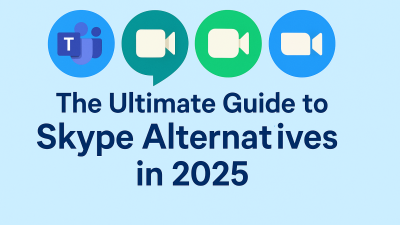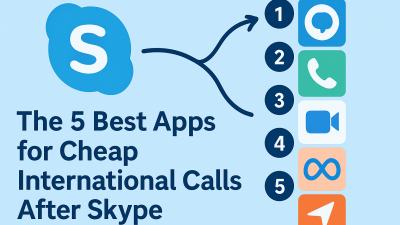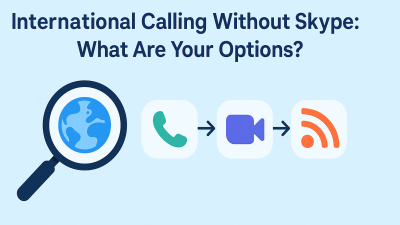When a tool you’ve relied on for years gets taken away, it’s more than inconvenient. It’s personal. Skype wasn’t just a video calling app. It was how people stayed connected across oceans, time zones, and years. It let you call your parents on their landline from across the world. It helped freelancers connect with international clients. It worked without a dozen logins or a calendar invite.
Now, with Microsoft pulling the plug on Skype in May 2025, everyone’s expected to move on, preferably into the arms of Microsoft Teams. But if you’ve tried Teams, you already know: it’s not built for casual, personal, or even lean professional communication. It’s structured. It’s layered. It feels like it expects you to schedule a meeting just to say hello.
This isn’t a review of Teams. It’s a reality check.
Not everyone wants their calls packed inside a dashboard. Not everyone wants chat to come with calendar integration. Some people just want to talk — clearly, easily, across borders.
This guide is for them.
The Problem With Most “Alternatives” Articles
Search for Skype alternatives and you’ll find the same list recycled over and over: Zoom, Google Meet, WhatsApp, maybe Viber if someone’s feeling adventurous. The logic is clear — they’re popular, easy to find, and free.
But what nobody’s really talking about is the core reason people used Skype: not app-to-app calls, not file sharing, not scheduled meetings. People used Skype because it could call any phone, in any country, at a price most people could afford.
Zoom and Meet don’t do that.
WhatsApp only works if the other person has WhatsApp.
Teams wants you to collaborate, not just call.
That’s the gap we’re focused on — and that’s where the hidden gems live.
What We’re Replacing: Clarity First, Not Feature Lists
The real power of Skype wasn’t just that it could make calls. It’s how accessible those calls were. You didn’t need the other person to be tech-savvy. You didn’t need to set up a profile picture. You could just type in a number and make the call.
That’s what’s missing from the so-called “modern” replacements.
This post doesn’t cover tools with “clean UI” or “fun filters.” It focuses on tools that do what Skype did well: connect you to anyone, anywhere, even if they’ve never heard of the app you’re using.
And that brings us to a standout contender, one that’s quietly doing the work Skype used to do, without pretending to be a social network.
MyTello: The Quiet Powerhouse You’ve Probably Never Tried

If you’ve been hunting for a true replacement for Skype’s international dial pad, skip the fluff. MyTello is it.
What sets MyTello apart isn’t flash. It’s focus. It exists for one reason: cheap, direct, reliable international calls. You don’t need to install anything extra. You don’t need to convince the person you’re calling to download an app. You can call a landline in India or a mobile in Nigeria as easily as you could with Skype.
You set up an account, choose the country you’re calling, see the price up front, and hit call. That’s it. The entire experience is built around making long-distance calls feel local and keeping them affordable without sacrificing sound quality.
There’s no upsell to a chat app. No attempt to wrap messaging around your voice experience. It doesn’t want to be your everything. It wants to be your phone.
For people who used Skype for staying in touch with family back home, for talking to clients in different time zones, for checking in with partners while on the move, MyTello isn’t just an alternative. It’s a continuation.
Why MyTello Isn’t on Every List — And Why That’s a Good Thing
Most tech media pushes whatever’s trending: big brand integrations, tools with investor backing, or apps that look good in screenshots. MyTello flies under the radar because it doesn’t play that game.
It doesn’t need to.
Its customer base is built from people who don’t want a dozen new features, they just want calls that work, prices they can understand, and support they can reach when something goes wrong.
That simplicity makes it one of the few tools that actually picks up where Skype left off. Not by copying the interface, but by understanding the use case.
It doesn’t want to replace your meetings. It wants to replace your long-distance bill.
The Experience: What It’s Like to Actually Use It
You create an account. No nonsense, no endless onboarding flow.
You pick a country — say, Pakistan.
You see the rates listed clearly. No surprises. No tricks.
You make your first call — often for free as a test.
And it just works.
The voice quality? Sharp.
The delays? Minimal.
The trust? Built fast, because nothing feels hidden.
This is what people thought they were losing when Skype announced its shutdown. But it’s not lost. It’s just moved.
When “Free” Comes at a Cost: Why Popular Isn’t Always Practical
Let’s talk about what happens when people search for Skype alternatives. They’re flooded with the same handful of names: Zoom, Google Meet, WhatsApp, Teams. Familiar apps. Free to install. Sounds good, right?
Until you try to call your aunt in Sri Lanka and realize she doesn’t use any of them.
This is where most guides fall apart. They focus on features, not purpose. They assume everyone wants video conferencing, team dashboards, or screen sharing. But if you used Skype to reach people outside the app world — landlines, older phones, business numbers — those tools don’t help.
So no, Zoom isn’t a Skype replacement. Neither is WhatsApp if the other person doesn’t even have a smartphone. And Teams? You already know the answer to that.
Replacing Skype means finding something that can make real calls, not just connect people who are already inside the same system.
Beyond MyTello: Niche Tools That Actually Fit Specific Needs
While MyTello covers the international call experience beautifully, there are a few lesser-known tools that quietly serve specific niches. These aren’t mass-market platforms. They’re focused, functional, and worth knowing — depending on what you need.
Yolla
If your top priority is calling international mobile numbers and you don’t mind installing an app, Yolla gets the job done. It’s clean, rates are competitive, and call quality is strong. But the interface can feel a little clunky, and their rate transparency isn’t as clear-cut as MyTello.
Google Voice
Useful only if you live in the U.S. and want a virtual number to forward calls or receive voicemails. It’s not built for international reach unless you’re calling from the U.S. — and even then, coverage is patchy. Great for freelancers with U.S.-based clients, not ideal for global families.
Quicktalk
Positioned as a VoIP system for businesses, but its pricing makes it accessible for individuals, too. The interface is more technical, and setup isn’t as fast as MyTello, but if you’re running a remote business and need call routing, Quicktalk has range.
None of these are replacements for Skype’s full range of users. But if you know what you need, and you need it done well, they can fill very specific gaps.
Why Teams and Zoom Keep Showing Up — and Why You Might Still Use Them
You’ll see Teams and Zoom in every comparison post, not because they’re the best fit for Skype users, but because they’re everywhere. People are already using them at work, which makes them easy defaults.
But that doesn’t mean they’re wrong for everyone.
Zoom, for example, is a solid option if:
-
You regularly meet with people in groups
-
You don’t need to call phone numbers
-
You want a familiar video chat experience
Teams might make sense if:
-
You’re already using Microsoft 365
-
You want chat + files + calls all in one place
-
You’re willing to adjust to its structure over time
Just know what you’re getting into. These tools are heavy. They assume your calls are part of a larger workflow. If that’s not you, they’ll always feel one size too big.
If You’re Just Trying to Stay in Touch With People You Love
This part matters.
A lot of Skype’s users weren’t teams or tech consultants. They were everyday people calling home, checking in with parents, talking to a partner, or managing a long-distance relationship. These weren’t work tools. They were lifelines.
If that’s you, here’s the key: don’t overcomplicate it.
You don’t need to “adapt” to something built for corporate life. You don’t have to tolerate an app that makes a simple call feel like a product demo. Find something that lets you hear their voice without delay, frustration, or fine print.
That’s where tools like MyTello come in. They don’t just work — they respect the simplicity of the connection. And if the people you’re calling don’t need to install anything, you’re one step closer to that connection happening easily, anytime, anywhere.
Replacing Skype Is About More Than Features — It’s About Fit

You’re not trying to replace a layout. You’re replacing an experience. Skype offered:
-
Direct calls without friction
-
Global reach at reasonable prices
-
Familiarity that didn’t require explanation
Most replacements don’t offer all three. That’s why so many feel off.
So the better question isn’t “Which tool is best?”
It’s: Which tool matches the way you actually communicate?
-
If you need to call landlines or mobiles worldwide, use MyTello
-
If you’re chatting with someone who already uses WhatsApp, use it
-
If you’re managing projects, maybe Zoom or Teams works
-
If you just want to talk without tech getting in the way, find the one that disappears when the call starts
Before You Decide: A Simple Test
Ask yourself this:
If Skype still worked, would I be looking for anything new?
If the answer is no, you’re not looking for more features, just a replacement that respects the simplicity — start with a tool that does one thing well.
Try a call on MyTello. See if it covers the gaps. Then try the others if it doesn’t.
This isn’t about adapting to a replacement. It’s about finding one that feels invisible once the call begins, just like Skype used to.
Closing: You Don’t Need More Tools — You Need the Right One
Microsoft Teams is big, polished, and connected to a thousand things. But if it doesn’t serve your need, it doesn’t matter how powerful it is.
What you’re looking for isn’t a platform. It’s a bridge. Something that works quietly, reliably, and affordably — no friction, no surprises.
That’s what Skype gave. That’s what you deserve in its place.
Tools like MyTello aren’t trying to replace Skype’s brand. They’re quietly preserving its value: helping you stay close to the people and places that matter, no matter where they are.




